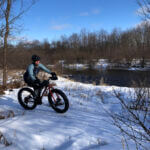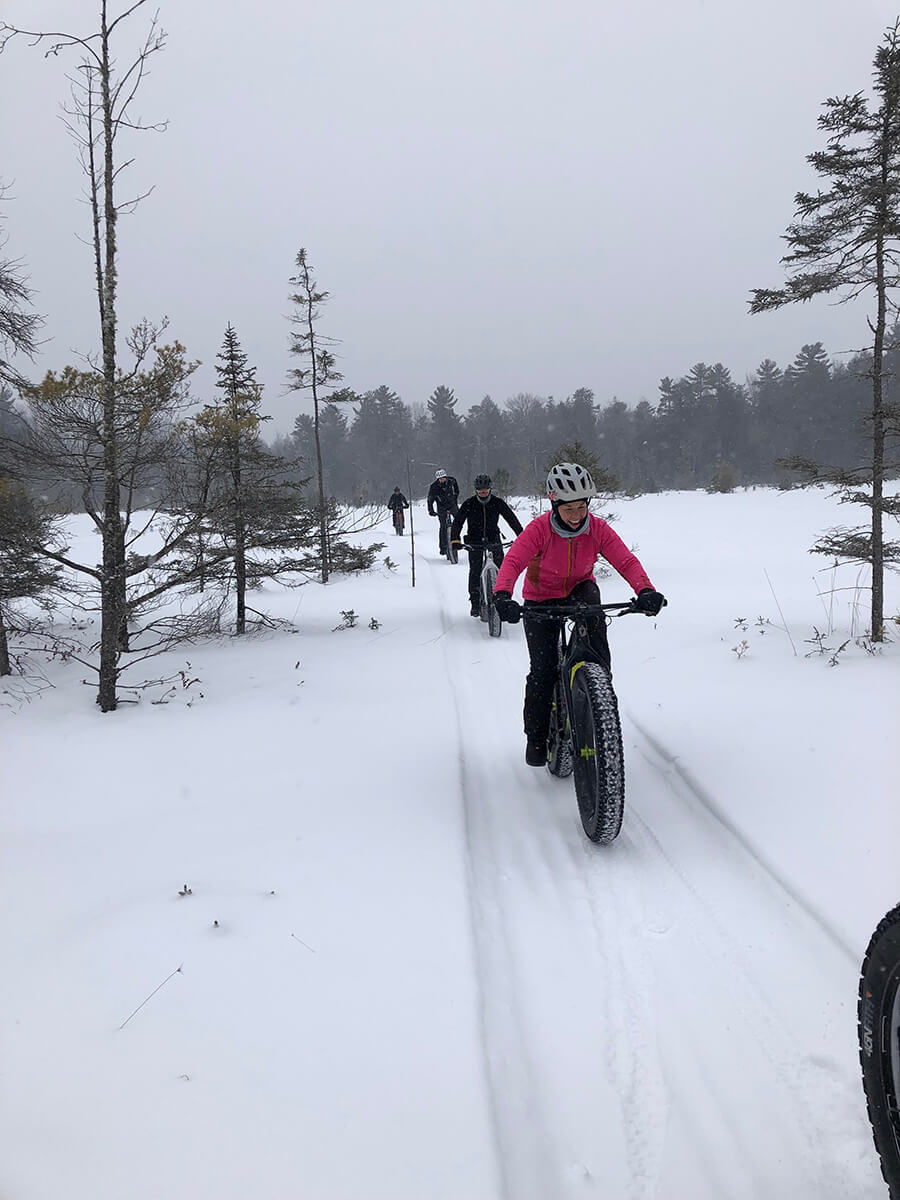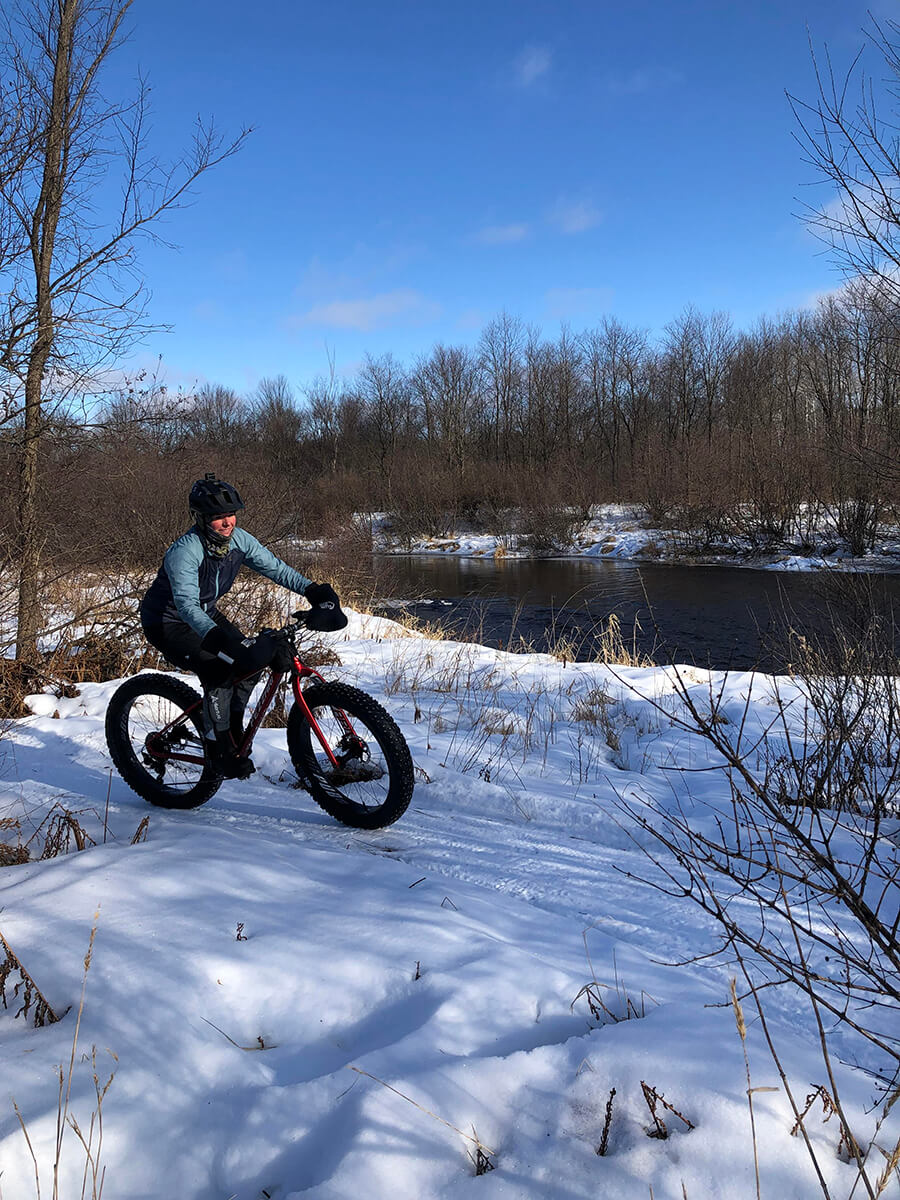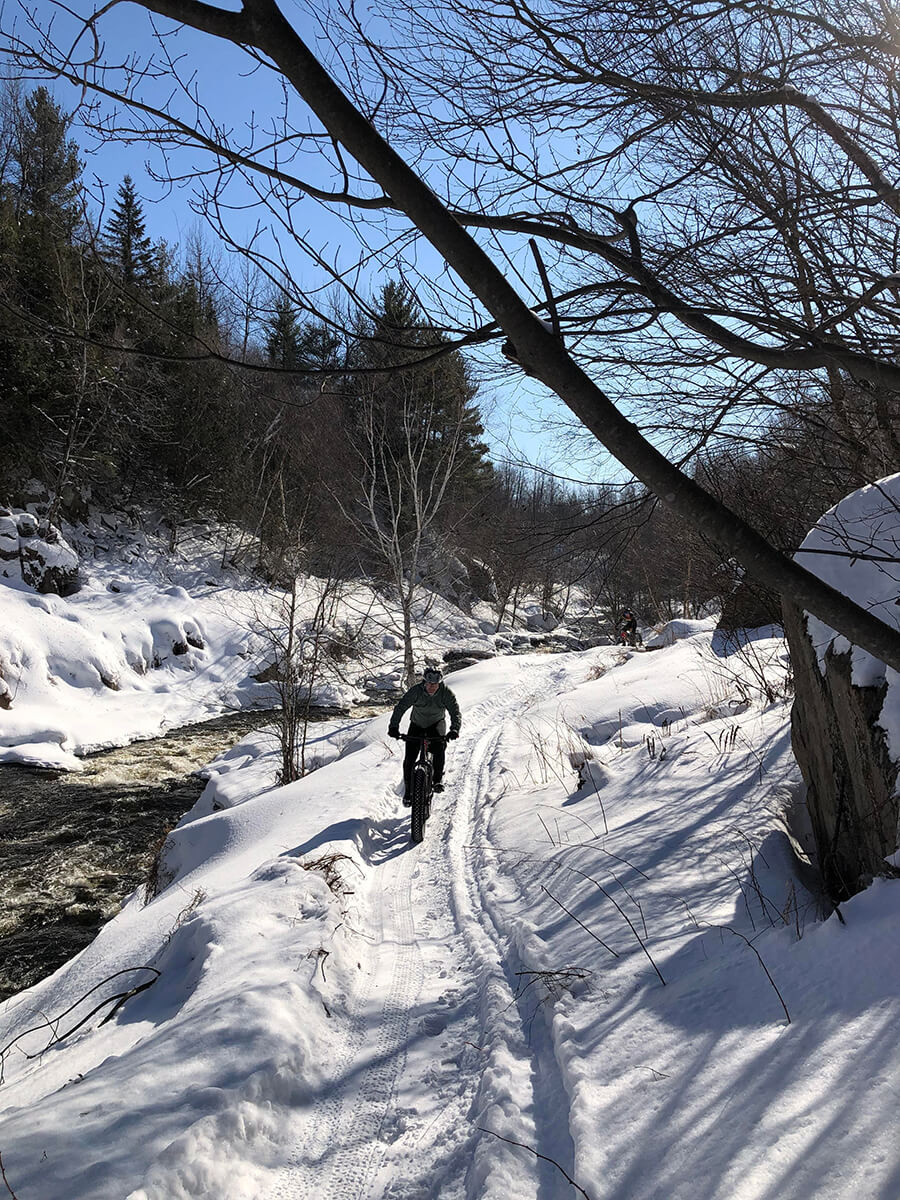
April 24, 2024
Biking is a favorite pastime in the Merrill area, with many types of bikes and a wide variety of bikers. Bike races and mountain biking are always popular in great weather here, but there is an ever-growing segment of the population—both visitors and residents alike—who are embracing fat tire biking in the snow. It’s an exhilarating experience!
Read on for tips and advice from a local fat biking enthusiast who lives in the area and loves winter riding.
What follows is an excerpt from a story that first appeared in the November 2023 issue of Silent Sports Magazine. [If you like the story, you can subscribe to Silent Sports Magazine via: shopmmclocal.com/product/silent-sports-magazine]
Rolling Fat this Winter: Get Started on Snow near Merrill
BY CHRIS SCHOTZ
The fat part is easy. The air gets colder, the days shorter. More cream is in my coffee and I'm 10 pounds bigger without even trying. December dawns and frozen lakes tempt me to do something naughty. It's fat bike time. This magical season can beat any day on dirt, and the Upper Midwest hits the snowy sweet spot.
New to fat biking? Read on for a primer to get you started and on the trails fast and furious.
Assured Snow?
While the snowline can migrate north to south as winter ebbs and flows, in a typical year Lincoln County provides for several months of great snow and lots of opportunities for fat bikers to get out on the trails. Groomed fat bike trails are so abundant in 2024 that poaching a ski or snowmobile trail would be a needless expenditure of goodwill, and I don’t have to go too far from my home in Gleason to hit on some great trails.
Northcentral Wisconsin offers 14 different groomed trails from Stevens Point to Minocqua, including a few with exclusive winter lines like the frozen shores of Big Eau Pleine and black spruce bogs at Enterprise.
For guaranteed snow measured in feet, head to Marquette where trails flow to the big lake from two rivers and two mountains, and Negaunee where rockstar groomers and an army of volunteers tame deep snow with a passion. Watch the forecast and posted conditions. Somewhere up north has to have perfect conditions, but don’t discount the amazing trails right here near Merrill for a great ride without the long drive.
In Lincoln County, the Underdown Recreation Area is your best bet and Prairie Dells features secluded swamps and a mile of whitewater canyon with malleable ice formations inaccessible in summer.

Seasons of Biking in the Underdown Recreation Area

For more information, check out these resources:
- facebook.com/underdowndells
- underdownhorseclub.com
- co.lincoln.wi.us/forestry-land-and-parks/page/underdown-recreation-area-0 (Includes bike, hike, horse, and cross country ski maps; trail opening and closing dates; trail conditions; and more.)
A maze of countless hills and meandering bogs makes the Underdown Recreation Area a year-round adventure destination. With 37 miles of remote mountain bike single track, 25 miles of noteworthy horse trails, and an Ice Age Trail segment, there is much to discover on bike, on horseback, or on foot. Lush greenery in the summer and an explosion of autumn colors reflect on five accessible lakes on Horn Lake Road and on the brink of the roaring canyon of the Prairie Dells.
Bike trails begin at the North Trailhead on Copper Lake Road with a rugged roll in old-school style over 70 hills, also open to hikers. A machine-built vibe engages the flow just south of Horn Lake Road all the way to the South Trailhead on Heineman Road and the brink of Prairie Dells. The Heinemania segment, created in 2023, takes the scenery and fun factor to a new pinnacle, linking Merrill Memorial Forest to Lincoln County Forest. Numerous locator maps will keep a wanderer on course, assuming they don’t get swept away by hidden gems and lose all track of time and space.
Bike and hike trails were built and maintained by volunteers along with the totally separate horse trail system maintained by the Underdown Horse Club, which includes four single-file diversions for equestrians up for a challenge. An expansive campground includes a pavilion and sites large enough for trailers on Copper Lake Road. All users should be mindful that, although it may seem like there is not another soul for miles, we are sharing this gorgeous location with others and should model good humor and patience upon those chance encounters between bike and horse and bear.
The Underdown doesn’t go into hibernation when fall gives way to winter. Lincoln County grooms a lengthy ski network with unbeatable classic skiing far into the backcountry. Journeys on skis start from the east end of the Copper Lake Road parking lot, while snowshoers start their hikes from the west end and take in winter-only views from frozen lakes and bogs, over a system of stacked loops up to the five-mile Dog Lake jaunt or eight-mile Mist Lake escapade. Skiers and hikers may cross paths with fat bikers who generally start their rides at the Prairie Dells Trailhead on Heineman Road. A full 25 miles of fat bike trails are groomed when conditions allow, notably the lines over remote lakes and along the Prairie River that are only accessible in winter. Bikes are not allowed on the groomed snowmobile and ski trails that they traverse except for a short section of Horn Lake Road.
Reasonably Geared & Priced
You might think that more bike means more money, but that might not be the case with a fat bike. With no suspension necessary, your winter ride could be the least expensive bike in the stable; and if only exposed to clean snow, the drivetrain and brakes will outlast the mountain bike you dragged through the mud. Keep it out of the salt and it will still feel new in spring. Blow your extra cash on lights and stylish footwear.
Tires are your point of contact with the temperamental snow, so give them due attention. There was a time when a 3. 8” tire was considered jumbo, but with so many options available in 2024, any tire under 4” could be reserved for race day when conditions are ideal. Those days of sidewalk-firm snow are exhilarating and more frequent as grooming technique advances, but a 4. 5” tire is your insurance on fresh snow. More important than the tire itself is the air that goes in it. The mistake new riders make most is believing that a fat bike is some kind of hovercraft that can float gently over any snow. Many show up at a recently groomed trail with 10psi in their tires and can’t figure out why they’re weaving around making snow angels. Riders on fresh snow must take care in order to have fun and preserve a rideable base for everyone. Lowering a tire to 3psi and watching those sidewalls wrinkle is scary, but it gets the job done. Fresh snow isn’t fast, but it is quiet. All you’ll hear is your fat friends huffing like bears. Fat biking can be a lot of work.
In a perfect world we’d all have a stable full of wheelsets ready for every condition, but there are no inexpensive fat bike tires. In general, a big knob is slower, but more versatile. Carbide studs are a game-changer on early-season lakes and late-season ice patches. Some have great luck setting up tubeless in winter, while some tire-rim combinations seem to be finicky and run flat when miles from the car. It takes a lot of air to fill a fat bike tire so keep your boot prints off the riding path when you get tired of pumping and walk out.
The array of fat bike wheels and tires is extensive, but you can’t go wrong with any 4. 5” knobby with tubes. Consult your local gearhead if you want to geek out about it, but don’t think too hard. Start your ride with higher pressure and let it out until you’re riding smooth.

Trail Lore
Watch for condition updates for your trail destination. Trails may be closed for a few days after a half-foot of new snow. If your local groomer wants snowshoes out in the powder to pack down a base, you should leave the bike at home and take that strenuous hike. A couple of inches of early-season snow can be ridden right away and will benefit from the traffic. Your groomer might pull a roller to build that base, or tires to buff out bumpy terrain through the swamps. Those snows need time and some help from Mother Nature to set up, so be patient.
Stay away if the temperature hits 35 degrees in the afternoon, and you’ll have dreamlike conditions the next morning. Some shady trails can tolerate hours at 38 degrees, while south-facing hills may break down at 30 degrees. Ride early in the morning. Be prepared to retreat.
Your groomer will often be out in the dark in the bitter cold. Freshly groomed snow can set up right away at minus-10, and strangely break down at 10-above the next day until moisture binds it over the ensuing days. By late January in a typical year, many trails will have enough of a solid base to allow your groomer to pull a rigid platform or plow, so you may be able to count on fast conditions sooner after a big snow. Settled snow in April may or may not grant a week of blissful crust riding through the trees.
Dress the Part
Follow Jack Frost’s familiar old rules to stay comfortable on a bike ride in winter: Dress in layers, starting with a moisture-wicking base. No cotton. Be chilly on the start line or you’ll be sweating on the first hill and then freeze your backbone. There’s no such thing as bad weather, only bad clothes.
Over the years, I’ve accumulated piles of base layers, jerseys, and different jackets, so I know the perfect combination from sub-zero to thaw riding. Specific tricks to fat bikes include pogies made by Bar Mitts and others that allow the use of light gloves in cold conditions. You’ll hear riders talk about handwarmers and electric gloves, usually when they fail and freeze your paws.
For your feet, expect to invest in Wolvhammers from 45NRTH or other specific boots if you plan on clipping into pedals. Quality hiking boots and gaiters are all you need for flat pedal comfort.
Keep that head in comfort! A beanie under your regular helmet usually does the trick, with a buff around your neck on colder nights. To reduce the risk of drink-freeze, extend your jacket over the hydration pack, especially the valve, and put energy bars in a jersey pocket a couple of layers deep so they don’t break your teeth. A flask of maple syrup takes a full hour to turn slushy inside a jacket at beardsicle-below zero. Ask me how I know.
It’s rare to ride in daylight after work in December and January, so you’ll want a lighting system to illuminate those winter group rides. My crew almost never rides at night in summer, but we’ll be out every week when the trails are that mystical white. I’ve got drawers of accumulated old lights, including three reputable brands that use a long wire to connect the battery to the light. After a few years of connecting helmets to back-pocket batteries, I learned that those wire connections are prone to kinking and failure at brittle temperatures. I finally bought a set from Chicago that keeps the battery and light in one unit with no wires. So far, the automotive-engineered Outbound lights on my helmet and bars are solid, bright, and easily adjustable.
Fat Bike Tire Society
When you’re ready to make some freezing friends, you’ll start with a Global Fat Bike Day party at the start of December. Racing can be anything from a hectic road race on a snowy golf course to a wild singletrack adventure. NOTE: The dates listed below are subject to change and do change from year-to-year, so check the resources listed to verify dates.
·The Hugh Jass series (hughjass.bike) runs from November to February in southern Wisconsin and, starting on January 6, you can find a race every weekend until March 9.
·Earn bonus minutes with a cornhole throw at the zippy Shannon Lake Fatathlon near St. Germaine, Wisconsin, before plunging into the Snow Crown Series (Green Bay Winter Ultra 100) around Green Bay on January 7. That four-race series culminates with the US Fat Bike Open on February 11, and compliments a virtual epic connecting six trails called the Green Bay Winter Ultra 100. Note also the Series’ Four Crash Course events on December 6, 13, 20, and 27. Check out: snowcrownseries.com.
·The Iola Snow Bully has a totally different vibe under Friday night lights on February 2. Epic adventures start in the U. P. on February 17 with the singletrack heavy Polar Roll mass start and its virtual monster EX routes.
·A week later and close to home, the IRONBULL Snowbound in the Underdown near Merrill in Lincoln County has remote single track routes from 9 to 25 miles over hills and several lakes and bogs barely accessible outside winter.
·The first weekend in March can take you to the sandstone mounds of Levis for the Sweaty Yeti, and March 9 can send you screaming down the Birkie ski trail at the Fat Bike Birkie.
Fat bikes are versatile and potentially addictive. Consider yourself warned: You may never look at winter the same way again!
Residents and Visitors Love Biking in Lincoln County
What are you waiting for? With so much recreational opportunity, life as a couch potato has no appeal whatsoever. Get up and get biking! If you live in the area, the opportunities are endless, and if you’re visiting the area, this is a great chance to embark on a northwoods biking adventure.
Whether you start in the warm season or dive straight into fat biking in the dead of our Wisconsin winter, you’ll come to enjoy every minute you spend living and biking in the heart of Wisconsin in Lincoln County “Where the Northwoods Start and Your Adventure Begins!” This is a great place to start your biking adventure.
